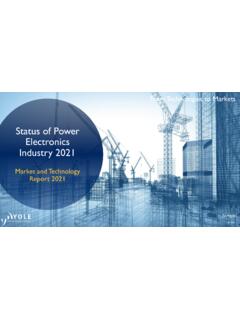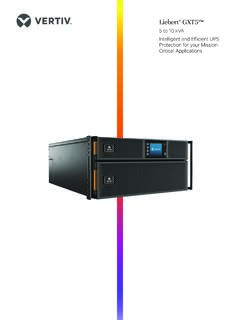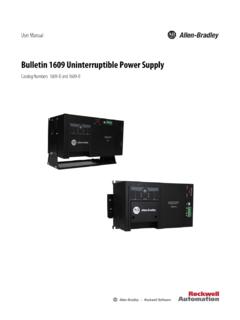Transcription of Calculating power requirements for HP ProLiant rack ...
1 Calculating power requirements for HP ProLiant rack-mounted systems technology brief 2 2 Key parameters .. 2 Input line 2 Device VA rating .. 3 Device input 3 BTUs required for cooling .. 3 Input/inrush current .. 3 Leakage 3 Determining power needs .. 3 HP power 5 Developing the calculators .. 5 Using the calculators .. 5 Example rack calculation .. 7 9 Do use the calculator for: .. 9 Do not use the calculator for: .. 9 For more 10 Call to action .. 10 Abstract With power requirements of computing equipment continuing to increase and the cost of energy forever rising, IT organizations need to obtain accurate estimates of power and cooling requirements when designing and expanding data centers.
2 The use of equipment nameplate ratings can yield inflated numbers that can result in overspending for power infrastructure components and a less efficient data center design. HP developed the power Calculator utility to enable IT planners to better estimate the power needs of HP ProLiant systems. This paper identifies factors affecting power needs, explains how the power Calculator works, and provides an example of how it is used. Introduction As integration technology evolves and system density increases, the amount of power once required for several racks of computing equipment is now consumed by systems housed in a single rack. A key benefit of high-density systems is the efficient use of valuable floor space.
3 Advances in processor architectures and speeds have resulted in performance-per-watt gains with a reduction in cost-per-transaction. Table 1 indicates an approximate 3x performance-per-watt increase over a four-year period. Table 1. Cost per tpm comparison HP ProLiant System Date of system availability TPC-C [1] Cabinet power $ price/tpm [2] DL580 6/900 4S Intel Xeon 10/15/01 kW $ DL585 G1 DC AMD Opteron 11/28/05 K kW $ NOTES: [1] Transaction Processing Performance Council benchmark of online transaction processing (OLTP) [2] tpm = transactions per minute Nevertheless, new applications and virtualization techniques require more processing and I/O capacity, and power consumption per rack will continue to increase.
4 Effective sizing of a computing infrastructure while managing IT costs requires realistic estimates of current and future power and cooling requirements . Determining the power consumption of individual racks can yield an estimate for the total consumption for a data center. It can also provide a starting point for determining power distribution requirements and cooling needs at the rack level. To determine power distribution, power redundancy, and battery backup requirements , the major active components within a rack must be analyzed for their needs based on operating parameters. Considerations such as system serviceability and scalability should also be taken into account during planning.
5 Key parameters Determining total power needs for a data center requires consideration of the key parameters described in the following paragraphs. Input line voltage Input voltage may be low-line or high-line voltage, and it is determined by what is available at the data facility. Low-line voltage [100 120 volts alternating current (VAC)] is commonly delivered to standard AC wall outlets in North America, while high-line voltage (200 240 VAC) is commonly used in other parts of the world but is also increasingly common in data centers in North America. Most HP server equipment is designed to operate in the 100- to 240-VAC range. Electrical equipment requiring high power consumption usually operates more efficiently at 200 240 VAC.
6 Using a higher voltage lowers current drain and creates less heat, thus reducing the 2 demand (kilowatt hours) on cooling systems while increasing equipment reliability. Some systems that can use either low-line or high-line power actually require high-line voltage to meet maximum performance specifications. Facilities may also distribute AC power as single- or three-phase. Three-phase high-line power (such as 3-phase 208 VAC in the ) is more efficient and recommended for systems requiring 3 kilowatts or greater. Device VA rating The total amount of power a device requires from the facility AC feed is known as apparent power and is measured in volt-amperes (VA).
7 Knowing the total amount of VA for all active components in a system helps IT designers determine the type and quantities of power distribution unit (PDU) and uninterruptible power supply (UPS) needed for a given rack configuration. Device input power The amount of power a device turns into work and dissipates as heat is known as real (or true) power and is measured in watts (W). Since any heat created by electrical equipment must be extracted, knowing the total amount of watts created by systems in a data center helps determine the cooling capacity needed by the facility. BTUs required for cooling The British Thermal Unit (BTU) is the standard for measuring the capacity of cooling systems.
8 The amount of power (watts) consumed by equipment determines the number of BTUs/hr required for component cooling, based on this formula: BTUs/hr = watts x For example: 399 watts x = 1360 BTUs/hr. Air conditioning equipment is typically rated in terms of tons of cooling, an old measurement based on the cooling ability of tons of ice (1 ton of cooling = 12000 BTUs/hr). Input/inrush current Input current is the amount of amperes a system draws during normal operation. However, when AC voltage is first applied ( power cord plugged in and/or a circuit breaker is switched on), power supplies of electrical components can momentarily draw several times more current than they will draw while operating.
9 This inrush current is cumulative across devices within a common power circuit, and it must be considered when building a rack. power supplies in HP servers include circuitry that minimizes inrush current. Staggering activation of segmented circuits can further reduce the effects of inrush current. Leakage current Leakage current (typically measured in milliamps) is residual current that originates in power supply filters and flows from chassis ground to the phase and neutral power conductors. Leakage current is cumulative across components within a power distribution circuit and can become a hazard if proper grounding procedures are not used.
10 Determining power needs Equipment power needs have commonly been determined in one of two ways: Nameplate ratings Actual power measurements 3 Nameplate ratings on power supplies typically represent the maximum amount of output power the supplies are capable of providing. Name plate ratings are typically based on the power needs of fully loaded servers configured for maximum processing and storage capability and running at 100 percent utilization. Since servers rarely are configured to their maximum and run at 100 percent utilization, estimating rack requirements using nameplate ratings would likely result in inflated power requirement numbers.







